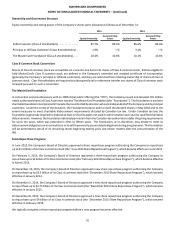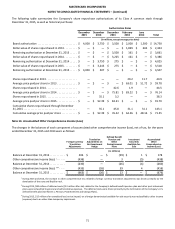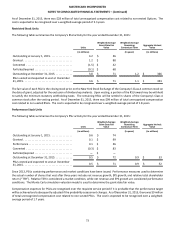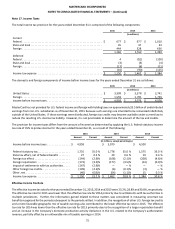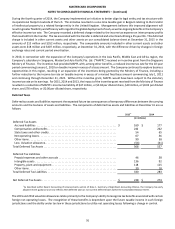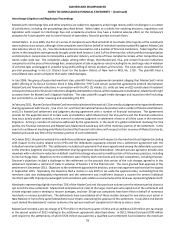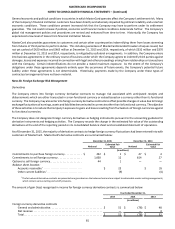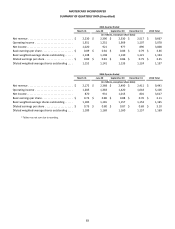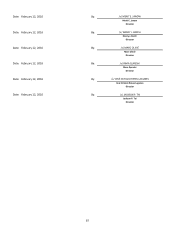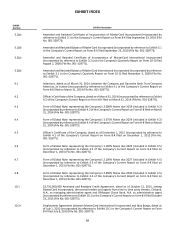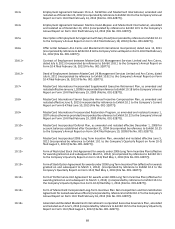MasterCard 2015 Annual Report Download - page 86
Download and view the complete annual report
Please find page 86 of the 2015 MasterCard annual report below. You can navigate through the pages in the report by either clicking on the pages listed below, or by using the keyword search tool below to find specific information within the annual report.
MASTERCARD INCORPORATED
NOTES TO CONSOLIDATED FINANCIAL STATEMENTS – (Continued)
80
MasterCard and Visa (the “ATM Operators Complaint”). Plaintiffs seek to represent a class of non-bank operators of ATM terminals
that operate ATM terminals in the United States with the discretion to determine the price of the ATM access fee for the terminals
they operate. Plaintiffs allege that MasterCard and Visa have violated Section 1 of the Sherman Act by imposing rules that require
ATM operators to charge non-discriminatory ATM surcharges for transactions processed over MasterCard’s and Visa’s respective
networks that are not greater than the surcharge for transactions over other networks accepted at the same ATM. Plaintiffs seek
both injunctive and monetary relief equal to treble the damages they claim to have sustained as a result of the alleged violations
and their costs of suit, including attorneys’ fees. Plaintiffs have not quantified their damages although they allege that they
expect damages to be in the tens of millions of dollars.
Subsequently, multiple related complaints were filed in the U.S. District Court for the District of Columbia alleging both federal
antitrust and multiple state unfair competition, consumer protection and common law claims against MasterCard and Visa on
behalf of putative classes of users of ATM services (the “ATM Consumer Complaints”). The claims in these actions largely mirror
the allegations made in the ATM Operators Complaint, although these complaints seek damages on behalf of consumers of ATM
services who pay allegedly inflated ATM fees at both bank and non-bank ATM operators as a result of the defendants’ ATM rules.
Plaintiffs seek both injunctive and monetary relief equal to treble the damages they claim to have sustained as a result of the
alleged violations and their costs of suit, including attorneys’ fees. Plaintiffs have not quantified their damages although they
allege that they expect damages to be in the tens of millions of dollars.
In January 2012, the plaintiffs in the ATM Operators Complaint and the ATM Consumer Complaints filed amended class action
complaints that largely mirror their prior complaints. In February 2013, the district court granted MasterCard’s motion to dismiss
the complaints for failure to state a claim. On appeal, the Court of Appeals reversed the district court’s order in August 2015 and
sent the case back for further proceedings.
Note 19. Settlement and Other Risk Management
MasterCard’s rules guarantee the settlement of many of the MasterCard, Cirrus and Maestro branded transactions between its
issuers and acquirers (“settlement risk”). Settlement exposure is the outstanding settlement risk to customers under MasterCard’s
rules due to the difference in timing between the payment transaction date and subsequent settlement. While the term and
amount of the guarantee are unlimited, the duration of settlement exposure is short term and typically limited to a few days.
Gross settlement exposure is estimated using the average daily card volume during the quarter multiplied by the estimated
number of days to settle. The Company has global risk management policies and procedures, which include risk standards, to
provide a framework for managing the Company’s settlement risk. Customer-reported transaction data and the transaction
clearing data underlying the settlement exposure calculation may be revised in subsequent reporting periods.
In the event that MasterCard effects a payment on behalf of a failed customer, MasterCard may seek an assignment of the
underlying receivables of the failed customer. Customers may be charged for the amount of any settlement loss incurred during
these ordinary course activities of the Company.
The Company’s global risk management policies and procedures are aimed at managing the settlement exposure. These risk
management procedures include interaction with the bank regulators of countries in which it operates, requiring customers to
make adjustments to settlement processes, and requiring collateral from customers. MasterCard requires certain customers that
are not in compliance with the Company’s risk standards in effect at the time of review to post collateral, typically in the form of
cash, letters of credit, or guarantees. This requirement is based on management’s review of the individual risk circumstances
for each customer that is out of compliance. In addition to these amounts, MasterCard holds collateral to cover variability and
future growth in customer programs. The Company may also hold collateral to pay merchants in the event of an acquirer failure.
Although the Company is not contractually obligated under its rules to effect such payments to merchants, the Company may
elect to do so to protect brand integrity. MasterCard monitors its credit risk portfolio on a regular basis and the adequacy of
collateral on hand. Additionally, from time to time, the Company reviews its risk management methodology and standards. As
such, the amounts of estimated settlement exposure are revised as necessary.
The Company’s estimated settlement exposure from MasterCard, Cirrus and Maestro branded transactions was as follows:
December 31,
2015
December 31,
2014
(in millions)
Gross settlement exposure . . . . . . . . . . . . . . . . . . . . . . . . . . . . . . . . . . . . . . . . . . . . . . . . . . . . . . . . . $ 39,674 $ 41,729
Settlement exposure covered by collateral . . . . . . . . . . . . . . . . . . . . . . . . . . . . . . . . . . . . . . . . . . . . (3,601) (3,415)
Net uncollateralized settlement exposure . . . . . . . . . . . . . . . . . . . . . . . . . . . . . . . . . . . . . . . . . . . . . $ 36,073 $ 38,314


